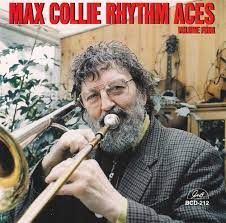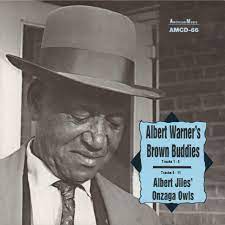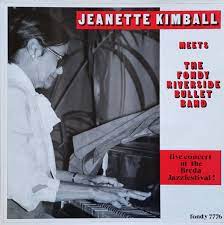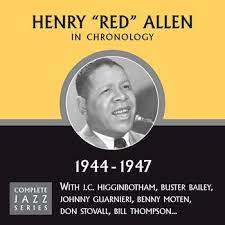
Daily Dose Of Jazz…
Minor Hall was born in Sellers, Louisiana on March 2, 1897 and was the younger brother of Tubby Hall. He studied at New Orleans University until 1914, then began playing with Kid Ory in the middle of the decade. He played in various New Orleans ensembles, including the Superior Band, then moved to Chicago, Illinois in 1918. He briefly took his brother’s spot in Lawrence Duhe’s band before serving in the U.S. Army during World War I. By the time he returned, King Oliver was leading Duhe’s band, which Hall rejoined in 1921.
In 1926 he played with Jimmie Noone, then moved to California for an extended run with Mutt Carey’s Jeffersonians from 1927 to 1932. He played in the Winslow Allen Band during the Thirties, but took a hiatus from music for part of the decade. He served briefly in the Army again in 1942.
In 1945 he rejoined Ory in his Creole Jazz Band, becoming one of his most long standing members. He remained with Ory’s ensemble until 1956, when he retired on account of poor health, having never led his own recording date, though he recorded extensively with Ory and with Louis Armstrong in the 1940s.
Drummer Minor Hall, better known as Ram Hall, died in Sawtelle, California at the age of 61 on October 16, 1959.
More Posts: drums,history,instrumental,jazz,music

Daily Dose Of Jazz…
John Maxwell Collie was born on February 21, 1931 in Melbourne, Australia. In 1946 he first heard professional jazz listening to Graham Bell’s lunchtime concerts at The New Theatre Melbourne. By 17 he was playing with a local band and shortly after leading it.
When he received the invitation by cable to take the trombone chair in the Melbourne New Orleans Jazz Band that was on tour in Europe, Max accepted and in 1962 arrived in England. He toured Europe until the band went back to Australia a year later, however, he decided to stay and joined the London City Stompers, becoming leader after a year. In 1966 he formed Max Collie’s Rhythm Aces and that band, notwithstanding the collapse of the UK jazz scene flourished.
The group released their first record in 1971 and in 1975 they won the World Championship of Jazz in traditional jazz against fourteen competing North American jazz bands in Indianapolis, Indiana.
He would go on to tour Sweden, Denmark, Finland, Norway and Japan and create a theater show. This show, Max Collie’s New Orleans Mardi Gras, which included Ken Colyer and Cy Laurie, turned out to be the most successful jazz show in British jazz history. Trombonist Max Collie died on January 6, 2018, at the age of 86.
More Posts: bandleader,history,instrumental,jazz,music,trombone

Daily Dose Of Jazz…
Albert Warner was born on December 31, 1890, in the Tremé neighborhood of New Orleans, Louisiana. Though his father was a string bass player, he didn’t seriously pick up the trombone until he was twenty-two years old. Taking lessons from one of his half-brothers, Ulysses Jackson, as well as Arthur Stevens and Honoré Dutrey. His main influences in his youth came from hearing Freddie Keppard, Vic Gaspard, and Baptiste Delisle.
His first professional jobs were playing for dance bands, including those led by “Big Eye” Louis Nelson, Kid Rena, Wooden Joe Nicholas, Buddy Petit, and Chris Kelly. In 1932 Warner joined the Eureka Brass Band and remained a regular member of this group until his death in 1966. His musical interplay with Charles Sonny Henry in the Eureka band during the late 1940s and 1950s is remembered by many for its intricacy and beauty.
The early Forties saw Albert playing and recording with Bunk Johnson and George Lewis. He would record often throughout the 1950s and in the Sixties he could be found playing frequently at Preservation Hall, accompanying the Preservation Hall band on a number of tours with Kid Sheik and the Eureka Brass Band. He went on one Memphis tour with Billie and DeDe Pierce in 1965.
Warner left behind a number of sessions recorded and released by Commodore, Pax, Folkways, Atlantic, and American. The album Bunk Johnson 1942/1945, Eureka Brass Band and The Eureka Brass Band in Rehearsal, a number of recordings with Charlie Love, Peter Bocage with His Creole Serenaders and the Love-Jiles Ragtime Orchestra, released by American. He also appeared on other American label albums recorded by Punch Miller, John Casimir, Kid Sheik and appeared on Atlantic’s Jazz at Preservation Hall series.
Trombonist Albert Warner, who performed in the traditional and brass band genres, transitioned on September 10, 1966 in New Orleans.
More Posts: bandleader,history,instrumental,jazz,music,trombone

Daily Dose Of Jazz…
Jeanette Kimball was born Jeanette Salvant on December 18, 1906 in Pass Christian, Mississippi, the niece of blues pianist Isadore “Tuts” Washington. When she was seven she began playing the piano and as a teenager she performed as a professional musician with classical string formations, then in the field of jazz.
Moving to New Orleans, Louisiana she played in traditional jazz bands, first in 1926 in a “society” dance band, Papa Celestin’s Original Tuxedo Orchestra, with whom she went on tour in the southern United States. By 1929 she had married Celestin’s banjo and guitar player Narvin Kimball, and six years later left the band to raise their children. Post divorce, she retained Kimball and started her career anew in the mid-1940s. She went on to work with Buddy Charles, Herb Leary and Sidney Desvigne.
The 1950s saw Kimball working again with Papa Celestin, when he reactivated his band, which then was under the guidance of Papa French. She was a member of the Preservation Hall Jazz Band and played with Clive Wilson’s Original Camellia Jazz Band.
She appeared in 1976 on the Jazz Festival Breda live 1999 album Jeanette Kimball Meets the Fondy Riverside Bullet Band; their album Sophisticated Lady with Frank Fields and Freddie Kohlman. In the field of jazz, Jeanette worked between 1953 and 1991 on 72 recording sessions, among others with Alvin Alcorn, Paul Barbarin, Papa Celestin, Punch Miller and Johnny St. Cyr.
She left New Orleans in the 1990s to live in Ohio and South Carolina. Pianist Jeanette Kimball, received the Black Men of Labor Jazz Legacy Award in 1998, transitioned in Charleston, South Carolina, at the age of 94 on March 28, 2001.
More Posts: history,instrumental,jazz,music,piano

Daily Dose Of Jazz…
Don Stovall was born on December 12, 1913 in St. Louis, Missouri. He began playing violin as a child before settling on the alto saxophone. He played around his hometown with Dewey Jackson and Fate Marable on riverboats in the 1920s, and then played with Eddie Johnson’s Crackerjacks in 1932-33.
During the 1930s he lived in Buffalo, New York where he led his own ensemble and played with Lil Armstrong. He moved to New York City in 1939, and played there with Sammy Price, Eddie Durham, and Cootie Williams.
Following this he recorded extensively with Red Allen, remaining with him until 1950. He also recorded with Pete Johnson and Snub Mosley over the course of his career, though he never recorded as a leader.
Retiring from the music industry in 1950 he spent the remainder of his life working for a telephone company. Alto saxophonist Don Stovall transitioned on November 20, 1970 in New York City.
More Posts: history,instrumental,jazz,music,saxophone




